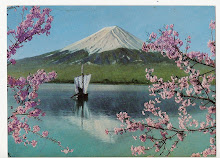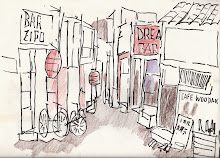EXTRA EXTRA, READ ALL ABOUT IT, MORE GREAT NEWS FROM OLD YOKOHAMA BY OKINAWA SOBA....
A SLOW DAY ON BENTEN STREET, YOKOHAMA -- The #1 International Shopping District During the Late Meiji Era, and the "PHOTOGRAPHERS ROW" OF OLD JAPAN (With Some Notes on the BRINKLEY SETS)
Ca.1895-1900 This view looks Southeast down Benten Street, called in Japanese, "Benten Dori" The clock tower on the left was built in 1894.
This shop-lined avenue is where almost all albumen souvenir photographs of Japan were made during the 19th Century. In fact, it is here on this street in 1896 that the effort was organized to produce what started out as an order for over 180,000 albumen prints to be tipped into the multi-volume sets of Brinkley's 1897 JAPAN - DESCRIBED AND ILLUSTRATED BY THE JAPANESE. However, some sources have said this order was eventually increased to 1,000,000 hand-colored prints --- all for the same publisher !
We now know that Yokohama photographer KOZABURO TAMAMURA whose studio was located at No.2 Benten Street was the one charged with coming up with this mountain of hand finished photographs to be pasted into the volumes of these silk-covered sets, and he called upon his Japanese photographer friends and acquaintances to bail him out !
The unbelievable initial order for for 180,000 photographs was so astounding, it made news in the Japanese papers of the day.
But, that was only the beginning.
Some sources have said this order was eventually increased to 1,000,000 hand-colored prints --- all for the same publisher ! Although I have not been able to track the "million" number down to a primary source, I have made some basic calculations based on Bethel's list of editions of this set (and some not on her list), and came up with way more than double the first installment of 180,000 prints --- actually well over 400,000 hand-made albumen photos (just for starters) !
There were also numerous editions that have no press-run figures, and the published also issued ART FOLIO sets that were filled with nothing but loose, mounted prints.
Although an accurate final figure might be impossible to obtain, the numbers so far certainly indicate the incredible amount of early Japanese photographs that came out of Yokohama during the 19th century.
The image above was photographed by KOZABURO TAMAMURA --- the same guy who had to come up with those 500,000 to 1,000,000 photos! Read all about this amazing production here :
www.flickr.com/photos/24443965@N08/3340015545/
Both TAMAMURA and T. ENAMI had studios at the far end of this street. The presence of many other photo studios along this strip of expensive real estate allowed it to also lay claim to being the "Photographers Row" of Old Japan. Even the famous KIMBEI opened his first studio here.
On busy days, it was packed with shoppers from all over the world --- sometimes to the point of 'rickshaw traffic jams. Even more than the Ginza in Tokyo, this street was the international shopping mecca for all who came to Japan. Arts, crafts, and "curios" galore were all here.
It was an especially colorful place to be during celebrations and festivals. However, Tamaura chose a quieter day to get his shot when all of those said decorations and crowds of people were not in the way.
Here are some other BENTEN STREET images on my stream, with additional caption commentary : www.flickr.com/search/?w=24443965@N08&q=BTSYOKO&m...
I've written more about TAMAMURA and T. ENAMI's photographic cooperation and friendship at www.t-enami.org/services
Uploaded by Okinawa Soba on 29 Mar 08, 4.40PM PDT.













